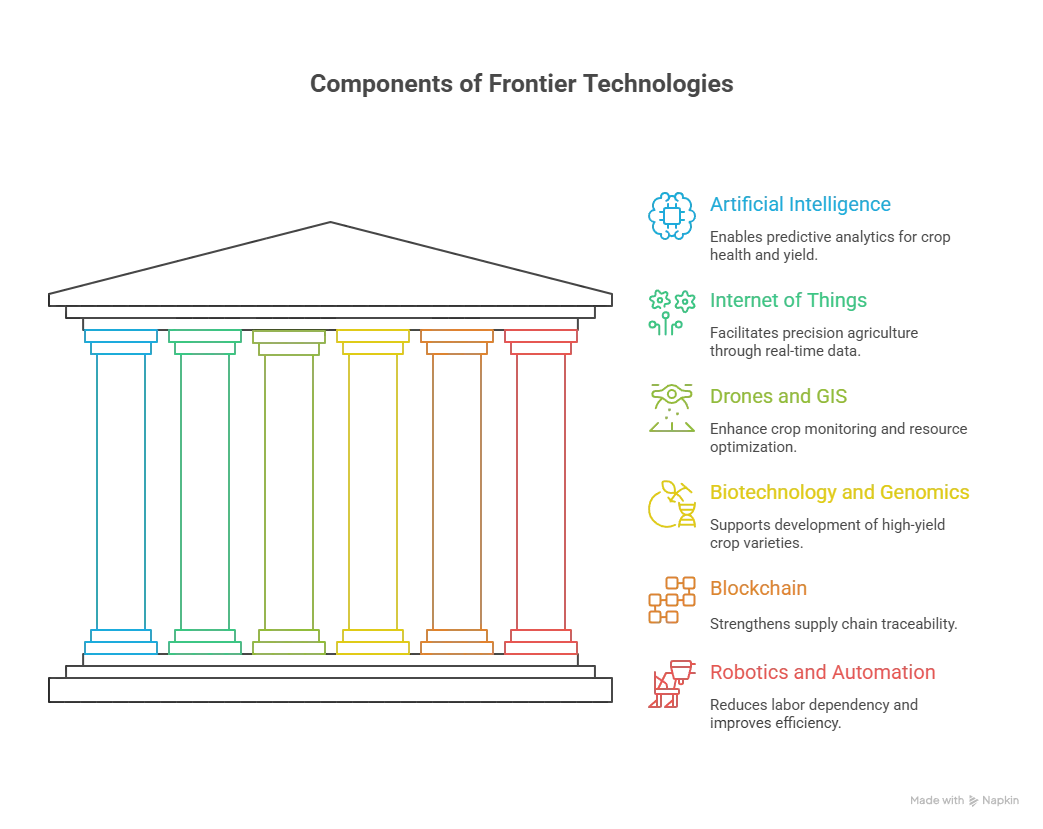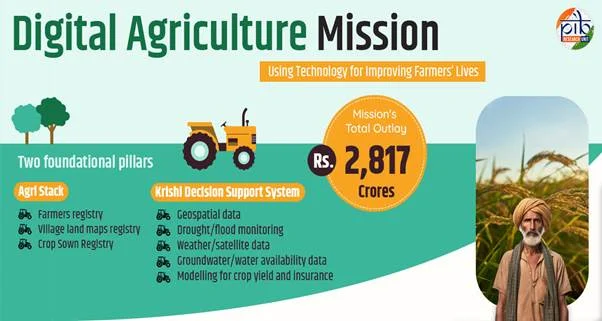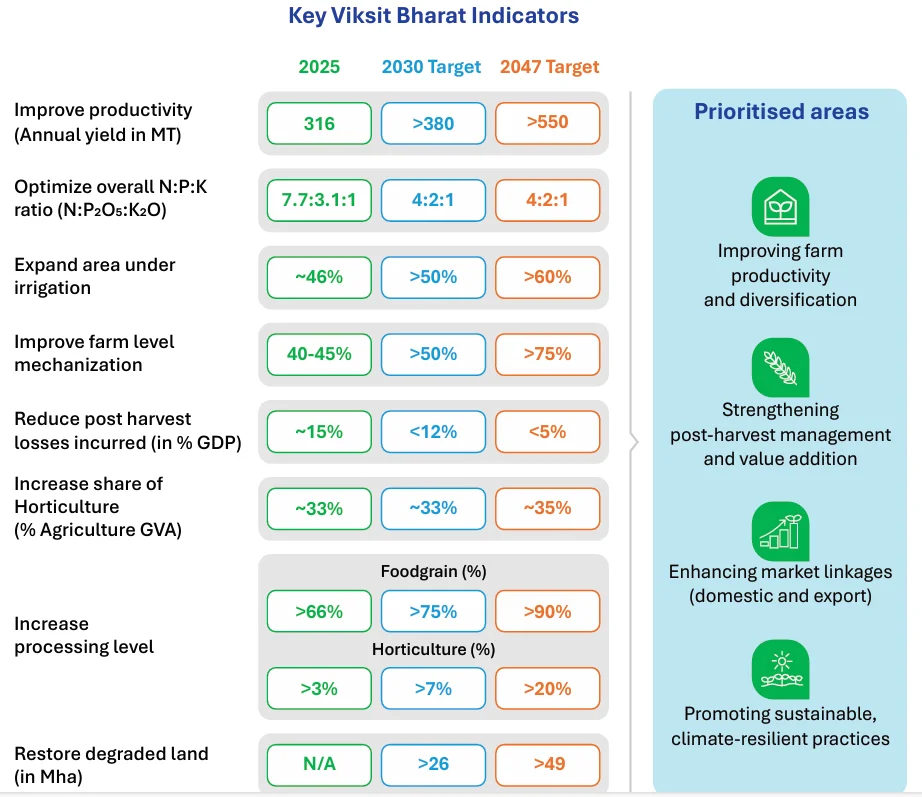Agriculture
Reimagining Agriculture: A Roadmap for Frontier Technology
- 06 Nov 2025
- 11 min read
For Prelims: NITI Aayog, AI, IoT, Biotechnology, Digital Agriculture Mission, Digital Public Infrastructure (DPI), AgriStack, Krishi Decision Support System (DSS).
For Mains: Key Highlights of the Reimagining Agriculture Report, Frontier Technologies Needed in Agriculture, Roadblocks to Tech Adoption in Agriculture and Way Forward.
Why in News?
The NITI Aayog released the report “Reimagining Agriculture: Roadmap for Frontier Technology-Led Transformation,” highlighting how AI, IoT, drones, and biotechnology can transform Indian agriculture.
- The roadmap proposes Digital Agriculture Mission 2.0 with three pillars — Enhance, Reimagine, and Converge — to drive technology-led agricultural transformation.
What are the Frontier-led Technologies in Agriculture?
- About: It encompasses advanced technologies revolutionising food, fiber, and fuel production, advancing toward an intelligent and sustainable food system through climate-resilient seeds, digital twins, and precision tools.
- Objectives: It seeks to shift agriculture from input-intensive to innovation-driven, using digital and scientific tools to ensure food security, climate resilience, and diverse incomes for farmers.
- Components of Frontier Technologies:
- Farmers Category: To holistically implement frontier technologies, the report divides farmers into 3 archetypes:
- Aspiring Farmers (70–80%): Small, rain-fed farmers needing micro-irrigation, credit, and market access.
- Transitioning Farmers (15–20%): Medium, entrepreneurial farmers seeking machinery, buyer linkages, and storage solutions.
- Advanced Farmers (1–2%): Large, export-focused farmers requiring blockchain traceability, advanced seeds, and robotics for global competitiveness.
Digital Agriculture Mission (DAM)
- About: Digital Agriculture Mission (DAM) is an umbrella scheme aimed at integrating Information and Communication Technologies (ICT) and data ecosystems to make farming profitable, sustainable, and data-driven.
- It supports Digital Public Infrastructure (DPI), Digital General Crop Estimation Survey (DGCES), and other IT-based initiatives by Central and State Governments, as well as academic and research institutions.
- Mission Components: The mission is anchored on 2 foundational components:
- AgriStack (Farmer-Centric Digital Infrastructure): It forms the foundation of Digital Agriculture by creating a unique Farmer ID linked to land, crop, and livestock data, as well as scheme benefits. The goal is to issue digital IDs to 11 crore farmers by FY 2026–27.
- Krishi Decision Support System (DSS): It is a geospatial intelligence system integrating remote sensing data with crop, soil, weather, and water information to enable crop mapping, disaster monitoring, yield assessment, and accurate crop insurance.
- DAM has 2 additional Critical Components such as Soil Profile Mapping and Digital General Crop Estimation Survey (DGCES).
- Significance: It promotes data-driven decision-making, transparency, and efficiency in resource use while empowering farmers through digital identities and targeted services.
- It also enhances climate resilience and economic inclusion, ensuring equitable access to credit, markets, and technology for small and marginal farmers.
What are the Key Challenges to Technology-Driven Agricultural Transformation in India?
- Data Integration and Governance Gaps: Lack of unified digital agri-infrastructure, despite initiatives like Digital Crop Survey and AgriStack, along with data privacy and farm data ownership concerns, remain key challenges.
- Market Linkage and Financial Access: Despite e-NAM, many farmers still depend on local mandis, while limited credit access hinders smallholders’ adoption of frontier technologies.
- Digital and Infrastructure Divide: Poor internet access, inadequate infrastructure, limited workforce, and weak digital literacy hinder the effective integration of digital tools, with only about 45% of rural households having internet access (NFHS-5).
- Ecosystem Fragmentation: Disjointed coordination among industry, academia, policymakers, and regulators restricts collective progress and slows ecosystem-wide transformation.
- About 86% of Indian farmers are small and marginal, restricting mechanisation and technology adoption.
- Talent Shortage: A lack of skilled, interdisciplinary professionals, including technicians, entrepreneurs, and tech-ready farmers, weakens the foundation for innovation and deployment of frontier technologies.
- Capital Constraints: Limited funding for high-risk, slow-scaling AgTech innovations and restricted credit access for farmers impede investment in transformative agricultural technologies.
What Steps are Needed for the Inclusive Agri-Tech Transformation?
- ENHANCE Foundational Systems: Develop a 360° Agri Kosh data ecosystem using data-mesh architecture for better decisions and AI-powered, multilingual last-mile advisory with two-way communication.
- Provide subsidies for tech-enabled farm inputs, and link DBT to digital farming adoption and yield gains.
- REIMAGINE Research & Talent: Shift from siloed research to mission-oriented, translational R&D focused on national priorities like climate-resilient seeds.
- Cultivate interdisciplinary talent through a national skills framework, industry-aligned curricula, and mass entrepreneurship programs.
- Train 1 lakh+ Krishi Sakhis, agri-extension workers, and progressive farmers as digital champions, and embed technology literacy in agriculture curriculums.
- CONVERGE Public-Private Efforts: Establish a national network of Frontier Technology Centres of Excellence (CoEs) to co-develop and pilot solutions.
- Promote pilots between start-ups, state governments, and FPOs, replicating models like Karnataka’s crop survey app and Andhra Pradesh’s digital FPOs.
- Institutionalise Policy Foresight Units and Regulatory Sandboxes to create agile and anticipatory governance.
Conclusion
NITI Aayog's roadmap envisions a tech-powered transformation of Indian agriculture to achieve Viksit Bharat 2047. By addressing systemic roadblocks through the three-pillar strategy of Enhance, Reimagine, and Converge, it aims to boost productivity, sustainability, and farmer incomes, transitioning the sector from input-intensive practices to an innovation-driven ecosystem.
|
Drishti Mains Question: Q. Discuss the significance of the proposed 'Digital Agriculture Mission 2.0'. How do its three pillars—Enhance, Reimagine, and Converge—aim to address the structural challenges faced by different farmer archetypes in India? |
Frequently Asked Questions (FAQs)
1. What is the Digital Agriculture Mission?
A national umbrella programme to embed ICT and data ecosystems in agriculture, anchored on AgriStack and the Krishi Decision Support System, to enable data-driven advisory, crop mapping, and last-mile services.
2. What is the core objective of NITI Aayog's "Reimagining Agriculture" roadmap?
The roadmap aims to transform Indian agriculture from being input-intensive to innovation-driven by leveraging frontier technologies like AI, IoT, and biotechnology to enhance productivity, sustainability, and farmer incomes, aligning with the Viksit Bharat 2047 vision.
3. Name the three farmer archetypes identified in the report and their primary characteristics.
The three archetypes are: Aspiring Farmers (70-80%, small & rain-fed), Transitioning Farmers (15-20%, medium & entrepreneurial), and Advanced Farmers (1-2%, large & export-oriented).
UPSC Civil Services Examination, Previous Year Question (PYQ)
Prelims
Q. What is/are the advantage/advantages of implementing the ‘National Agriculture Market’ scheme? (2017)
- It is a pan-India electronic trading portal for agricultural commodities.
- It provides the farmers access to nationwide market, with prices commensurate with the quality of their produce.
Select the correct answer using the code given below:
(a) 1 only
(b) 2 only
(c) Both 1 and 2
(d) Neither 1 nor 2
Ans: (c)
Mains
Q. How is science interwoven deeply with our lives? What are the striking changes in agriculture triggered off by science-based technologies? (2020)










